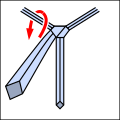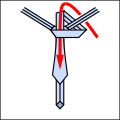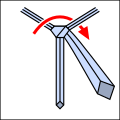Pratt knot
This article contains instructions, advice, or how-to content. (August 2014) |
The Pratt knot is a method of tying a tie around one's neck and collar. It is also known as the Shelby knot and the Pratt-Shelby. The knot was worn by Jerry Pratt, an employee of the US Chamber of Commerce. He had been wearing his tie this way for some twenty years before it became popular after TV personality Don Shelby wore it on air. The New York fashion press then promptly attributed the invention of the knot to Shelby.
The Pratt knot is unusual in that its starting position is 'reverse side out', like the Nicky knot, a self-releasing variant of the Pratt. It uses less length than the half-Windsor or Windsor knots, and so is well suited to shorter ties or taller men. Unlike the four-in-hand knot, the Pratt method produces a symmetrical knot. It is of medium thickness.
Although these "reverse side out" knots have been attributed to various recent "inventors" ("Pratt", "Shelby") or given fanciful "dedicatory names" ("Nicky" is supposed to derive from the visit of Nikita Khrushchev to Milan), the Pratt knot has actually been quite commonly used among Milanese tailors since at least the 1920s, having the advantage of being quite easy to tie a perfect knot on a shop-window mannequin. In Italy, it is referred to as the nodo alla milanese ("Milan-style knot").
Using notation from and according to The 85 Ways to Tie a Tie, the knot is tied
- Lo Ci Lo Ri Co T (knot 5)
The Nicky is tied
- Lo Ci Ro Li Co T (knot 4)
See also
External links
- Encyclopedia of tie knots at Thomas Fink's homepage
- Grog. "Pratt (Shelby) tying guide". Animated Knots. Retrieved April 2013.
{{cite web}}: Check date values in:|access-date=(help) - Pratt (Shelby) tying guide at TieGuide.com
- Neckties at Curlie







